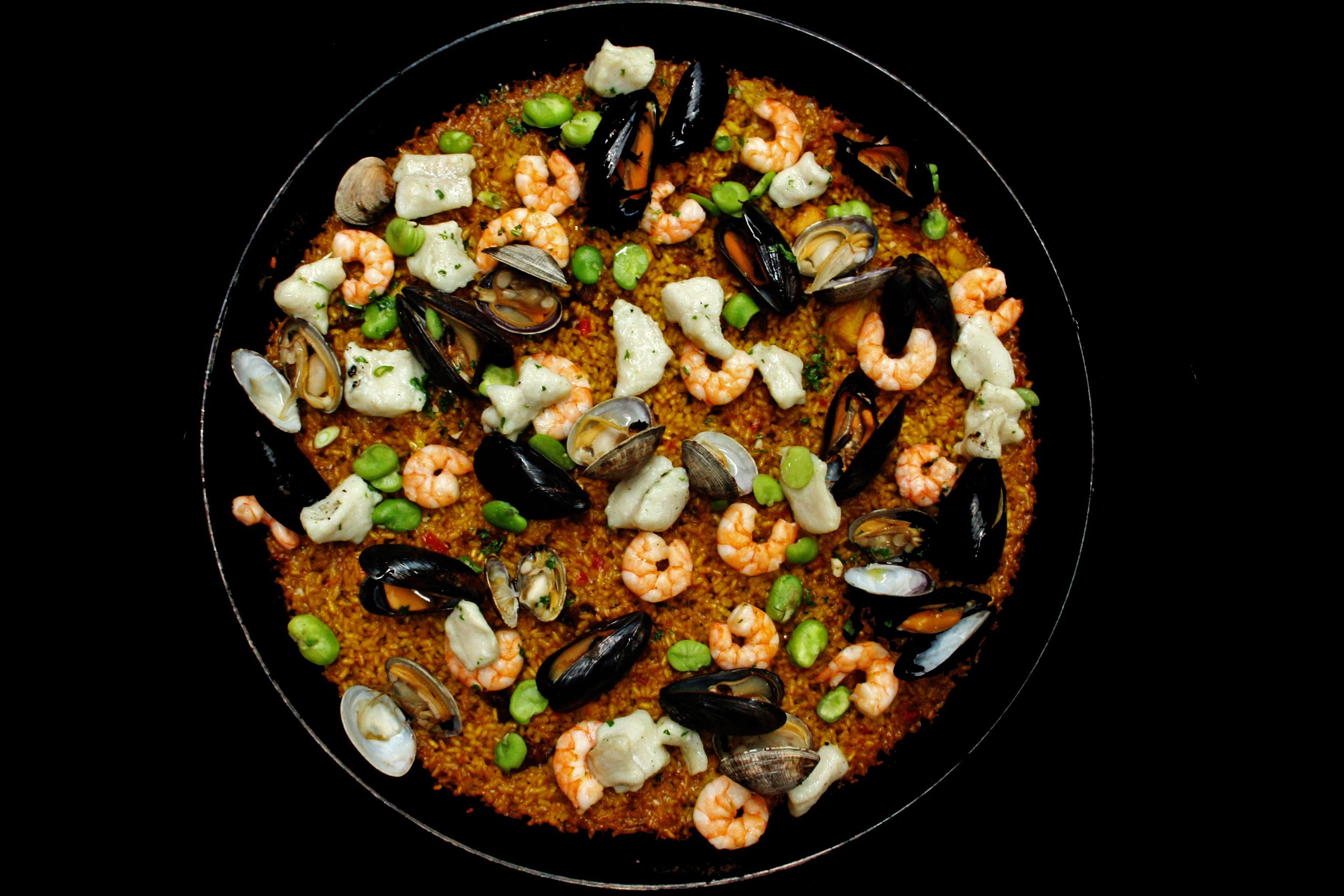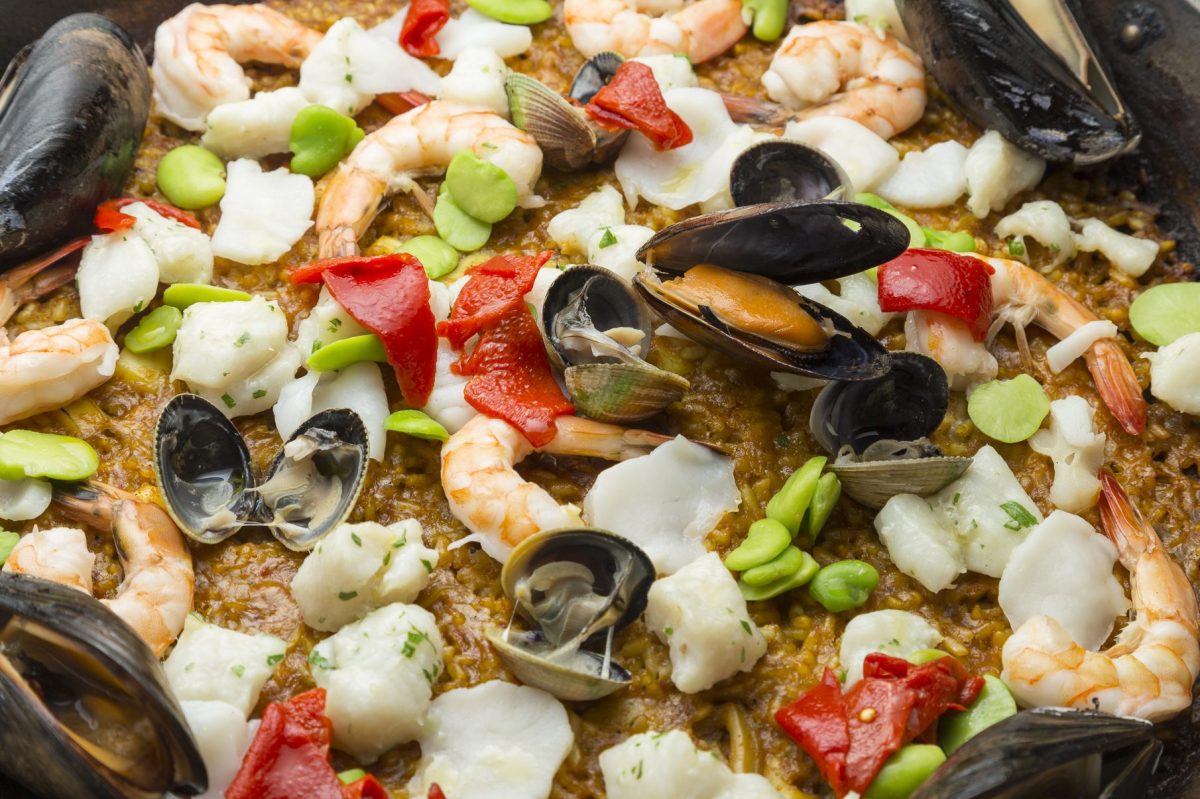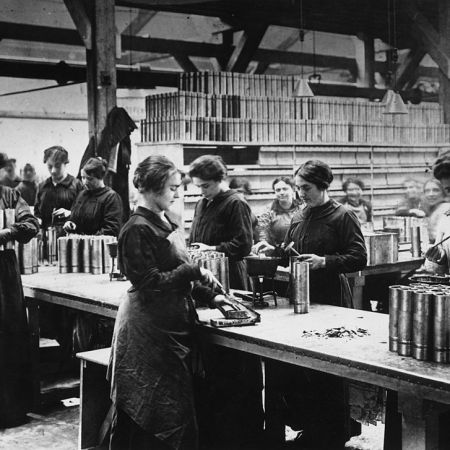Often referred to as the national dish of Spain, paella traces its roots to the eastern shores of Europe in the port city of Valencia on the edge of the Mediterranean, and the rice that the Moors brought with them when they conquered the region.
As the story goes, the dish was created when servants of the Moorish kings began scraping together meals for their families by taking the leftover scraps from royal banquets and cooking them together in giant pots with rice and anything else that it was easy to get their hands on — including tomatoes, beans, onions and sometimes even snails or rabbits. With Valencia being a port city, shellfish and other seafood soon made their way into the humble dish.
As for the name, paella takes its moniker from the flat, oversized pan that the dish ended up commonly being cooked in over an open fire, “la paella.” In addition to a cooking vessel, the double-handled pan also doubled as a serving vessel people would gather around and eat from it with wooden spoons.
Your home kitchen, sadly, probably does have a fire pit. It also, sadly, probably does not have a big, ol’ paella pan.
But, as Chef Lolo Manso of three-restaurant chain Socarrat Paella Bar in New York City explains, that doesn’t mean you can’t make paella at home as the pan and open fire are not required as long as the dish meets other mandatory requirements.
“There are no rules for cooking paella. You can make paella in a casserole dish, thick cast-iron pan or even a frying pan,” Manso tells InsideHook. “If you use the paella pan, great. But if you never use it, it can be great as well. It’s different, but it’s not the end of the world. At the end of the day, paella is a comfort food that you can make anywhere. You can cook the same thing in a wok that you can in a frying pan. Same thing with the paella pan. As long as you cook the rice nicely and it tastes good, you can do paella anywhere.”

No matter what it is cooked in — and a thick cast-iron pan works just fine — paella must have a broth base, well-cooked rice that stays firm and doesn’t get soggy and draw its flavoring from a mixture of finely chopped vegetables simmered in oil with garlic that’s known as sofrito. Another key component of paella is where Manso’s collection of restaurants gets its name: socarrat.
“We looked it up somewhere and the definition is socarrat is the ‘seductive caramelization of the bottom layer of a perfect paella when the liquid is absorbed and the rice is done.’ It’s when the rice in the pan gets a little dry and a little crispy and very crunchy. It’s a crust on the bottom of the pan with a nice texture. Every country that makes rice has a dish where the rice gets dry, crispy and is crunchy that is their version of socarrat.”
Except possibly France, based on a story Manso heard many years ago.
“I don’t know if it’s true or not, but there used to be a story about a very famous French chef having paella for the first time,” he says. “After trying it, he said, ‘Oh my God, this is terrible. This is seafood, chicken and beef. That’s just disgusting.’ It was a lot of things together, but after he finished he said, “But I really like it. It’s so good.” Paella is something special. When you do it right is, I think it is a masterpiece. I have family in Spain that I don’t see that often. I love them and they are great, but I don’t go to see them as much as I am supposed to. With paella it’s the same thing. It’s something wonderful and great that people don’t eat as much as they are supposed to.”
Now that we’re all free from The Pan, that can certainly change.
Paella de Pescado y Marisco
Ingredients
- Rice 4oz
- Fish broth 16oz
- Olive oil 2tbsp
- Tomato 1pc
- Onion 2oz
- Garlic 1clove
- Scallop 3pc
- Shrimp small 8pc
- Whitefish 5oz
- Calamari 3oz
- Clams 3pc
- Mussels 6pc
- A thick cast-iron pan, preferably 15 inches
- Salt and pepper to taste
- Fish broth is advised, but chicken broth works well too. Fresh seafood is best, but frozen seafood mix can be substituted.
Instructions
- Dice (small) onion and tomato, mince the garlic.
- Clean and slice calamari, Peel shrimp or buy them peeled.
- Dice (large) white fish, Slice scallop in half, Wash clams and mussels.
- Place all the ingredients in a separate bowl.
- On the medium heat burner, place the pan and add olive oil, chopped tomato, onion and garlic. Cook them slowly for 8-10 min, then add calamari and rice, and cook for 2 more minutes.
- Add fish broth and turn the stove to high.
- Preheat the oven to 450 degrees.
- Keep stirring the mix until the broth evaporates by 75%.
- Place the pan in the oven, cook for 15-20min. Check every 7 minutes and rotate the pan in the oven.
- When the rice is getting a golden color around the edges of the pan and the broth has mostly evaporated, the pan is ready to be taken out of the oven.
- Place the seafood on top of rice and put it back in the oven for another 5-6 min to cook the seafood. Make sure that the mussels and clams are cooked and that their shells are open.
- Take the pan from the oven and drizzle on some olive oil. Salt and pepper to taste.
- Let the paella rest for a few min before serving.
- You can top with some fresh peas and some sliced piquillo pepper for color.
Every Thursday, our resident experts see to it that you’re up to date on the latest from the world of drinks. Trend reports, bottle reviews, cocktail recipes and more. Sign up for THE SPILL now.























